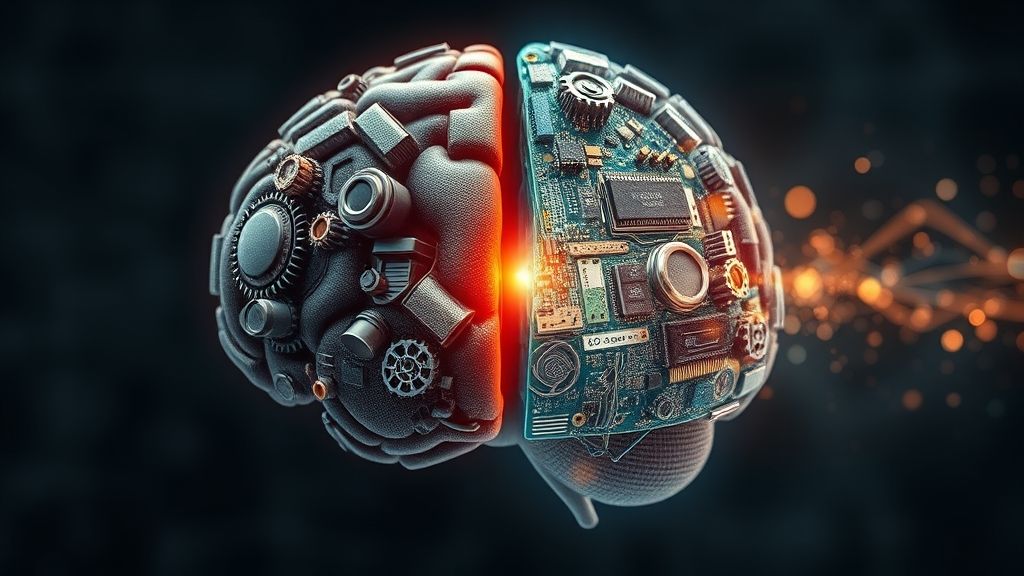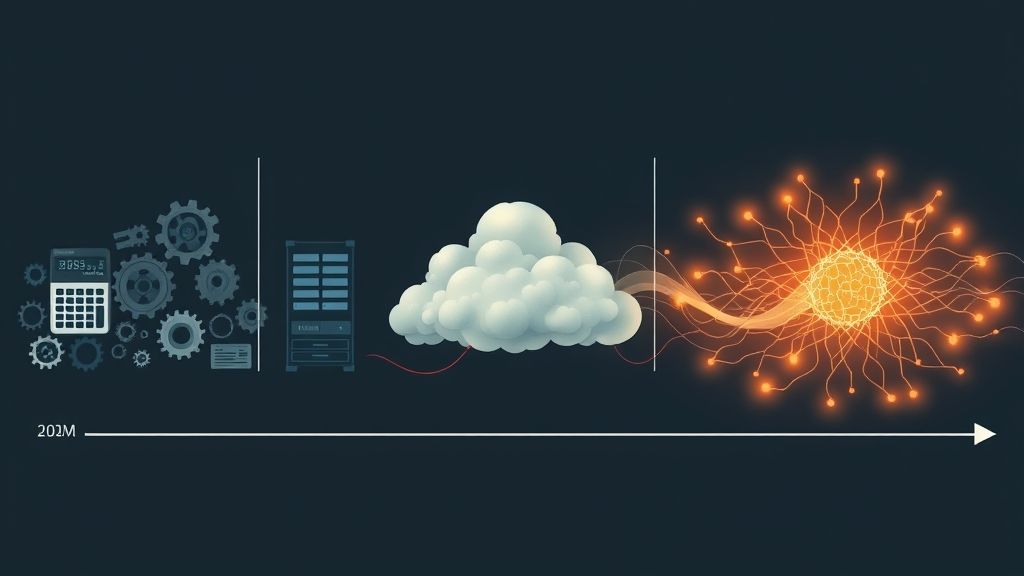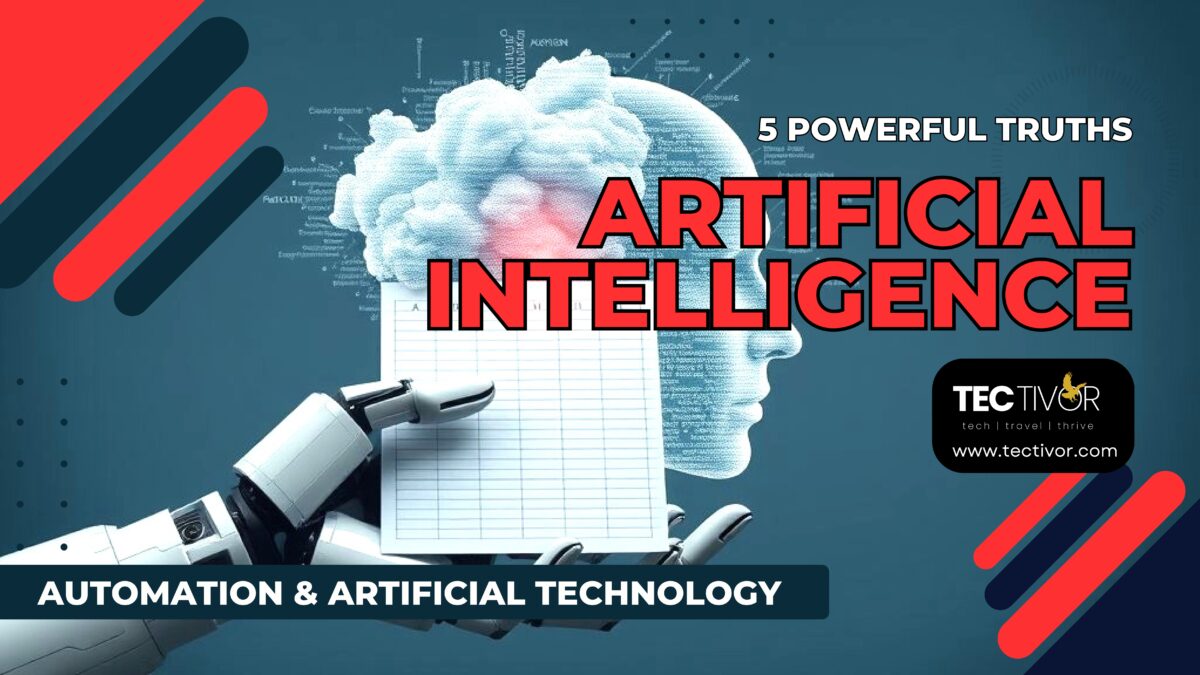The term Artificial Intelligence (AI) has traveled a long way from its origins in mid-20th-century computer labs to today’s corporate boardrooms, marketing campaigns, and everyday conversations. What once meant machines that could reason, plan, and learn like humans is now used to describe almost anything: cloud computing, data mining, automation tools, and even basic programming. This dramatic expansion of the term’s scope has created both enormous excitement and widespread confusion.
The danger in this linguistic inflation is simple: if everything is AI, then nothing is AI. The term loses its specific, powerful meaning. To make sense of this, let’s cut through the hype and look at five powerful truths about automation, machine learning, and artificial technology that can help us separate genuine intelligence from clever marketing and understand the real impact of these systems.
Table of Contents
Artificial Intelligence Was Never Just “Technology”—It Was a Philosophical Quest
When researchers first coined the term Artificial Intelligence in the 1950s at the Dartmouth Workshop, they weren’t trying to describe technology in general. They wanted to replicate the core, high-level functions of the human brain: problem-solving, reasoning, planning, and learning. This was a grand, philosophical quest—not just an engineering problem.
Early experiments—such as programs that played chess or proved mathematical theorems—were clumsy but ambitious. They weren’t about crunching numbers faster (that was already what computers did). They were about exploring whether machines could genuinely “think” and demonstrate high-level cognitive behavior. The focus was on creating a system with general intelligence, similar to a human, a concept now known as Artificial General Intelligence (AGI).
Today, the phrase Artificial Technology sometimes appears in conversations to capture the blending of human-like cognition and tool creation. But that’s more a philosophical stretch than a precise technical one. AI was always supposed to be distinct from basic technology; it was a field dedicated to intelligence, not mere utility. The initial vision aimed for creation, not just calculation, making the distinction between a simple program and a truly intelligent system critical.
Automation vs. AI: The Distinction Between Rules and Adaptation
Here is where much of the marketplace confusion comes in, making a careful distinction between Automation and AI essential.
Streamlined processes fundamentally means following fixed rules or instructions to complete tasks faster and more reliably. A simple Excel macro that calculates a formula, or a factory robot that welds a car part at the exact same location every time, is a form of automation. These systems excel at repetition but lack judgment: there is no learning, no adaptation, and no deviation—just execution of a predefined script.

By contrast, AI and its key methodology, ML algorithms, involve systems that dynamically adapt and improve based on data. For example, a Data-driven models model trained on thousands of x-rays can predict potential illnesses it has never seen before by finding complex patterns in the data. This difference—between rigid, rule-based execution and flexible, data-driven inference—is at the heart of why AI feels closer to intelligence than simple Streamlined processes does. ML algorithms enables the system to construct its own rules from examples, which is a major leap forward.
The problem is that in popular and marketing language, this powerful distinction often disappears. When an office software package adds an autofill feature or a simple workflow task, it may get branded as “AI-powered,” even if it’s just a rudimentary algorithm or formula running behind the scenes. This blurring risks devaluing genuine advances in AI by equating them with basic, decades-old Streamlined processes tools.
Cloud Computing and Data Management: The Essential Platform, Not the Intelligence
Another common myth is that cloud computing or large-scale data management are themselves forms of AI. They are not the intelligence, but they are absolutely essential to modern AI’s existence.

Cloud-based systems is infrastructure: a vast, distributed system of servers that allows for storage, networking, and computation at a massive scale. Without the near-limitless resources of the cloud, modern large-scale Data-driven models—which require gargantuan amounts of processing power—would simply not be feasible. However, the cloud itself does not “think”; it merely hosts the processes. It is the canvas upon which the AI is painted.
Similarly, Data Mining is analysis: the process of discovering patterns, anomalies, and insights in large datasets. It can be manual or heavily automated, but not all data mining uses AI techniques. You can use simple statistical methods to mine data.
Still, because these fields are the essential preconditions for major AI projects, the lines blur. The result: many people equate any large-scale data operation, particularly those run on the cloud, with artificial intelligence, even though the underlying technology and function are technically distinct. Virtual infrastructure is the utility grid; AI is the complex appliance plugged into it.
Machine Learning and Generative AI: Bringing Us Closer to the Original Dream
Where AI truly stands out today is in systems built on advanced Machine Learning—specifically, the rise of Generative AI like models that can produce human-like text, images, code, or even audio. Unlike simple Streamlined processes or rule-based software, these systems are not explicitly programmed with every possible output or sentence. Instead, they generate new, novel responses by learning from vast, complex patterns in human language and data.
This ability to generate novel content and adapt to complex, unstructured prompts brings us much closer to the original vision of Artificial Intelligence—machines that do not just execute instructions but can create, adapt, and converse in ways that mimic human cognition. These models demonstrate a form of ML algorithms that goes beyond simple classification or prediction.
That’s why talking to a generative AI can feel qualitatively different from using traditional software. It actively blurs the line between simplistic Streamlined processes and complex cognition and shows the immense promise of future Artificial Technology that may one day resemble human intelligence even more closely, leading toward AGI. It represents the most compelling modern argument for the term AI.

Words Shape Perception—And Perception Shapes Artificial Technology
The fifth truth is more philosophical and socio-economic: the way we use language matters deeply. Calling everything “AI” risks flattening important distinctions, which can lead to misinvestment and disappointment. But it also reflects how society increasingly experiences all advanced computation as part of a continuum of intelligence.
From a strict technical view, we should keep the categories clear to ensure proper research and development:
- Automation = fixed rules, repeatable actions, and predefined workflows.
- Machine Learning = adaptive, data-driven inference used for prediction and complex pattern recognition.
- Artificial Intelligence (Narrow) = specific systems that attempt to replicate human-like reasoning or learning in a constrained domain (e.g., medical diagnostics).
- Artificial General Intelligence (AGI) = still theoretical, describing machines with human-level flexibility and the ability to perform any intellectual task a human can.
From a cultural view, though, people experience them as merging into one unified system. Whether it’s a predictive text feature, a cloud service, or a sophisticated ML algorithms model, the technology feels like it is “thinking” because the underlying logic is opaque to the user. That perception is why Artificial Technology as a broad umbrella term resonates—it captures the user’s experience of a “smart” machine, even if it’s not technically precise.
Conclusion: Guarding Meaning in an Age of Hype
The future of AI depends not only on technical progress but also on how clearly and precisely we choose to talk about it. If Process Automation, Virtual infrastructure, data mining, and machine learning all collapse into a single, overused word—“AI”—we risk blurring the critical boundary between genuine, transformative innovation and routine computational tools. This can mislead investors and policymakers alike.
At the same time, this linguistic drift reflects a deeper, undeniable truth: humans and machines are no longer separate actors. We are creating a shared ecosystem where artificial and human cognition interweave, giving rise to the pervasive idea of Artificial Technology.
So perhaps the greatest challenge is not to stop people from calling a spreadsheet or the cloud “AI,” but to stay acutely mindful of what’s really happening under the hood. By holding on to clear distinctions between rule-based Streamlined processes and adaptive machine learning, we can better appreciate what makes genuine Artificial Intelligence extraordinary—while also recognizing the quiet, reliable power of simple Streamlined processes. In the end, the myths around AI are not just about technology; they’re about us—our hopes, our fears, and our tendency to see intelligence wherever we find something useful. And that, more than anything else, will shape what the future of Artificial Technology ultimately becomes.


